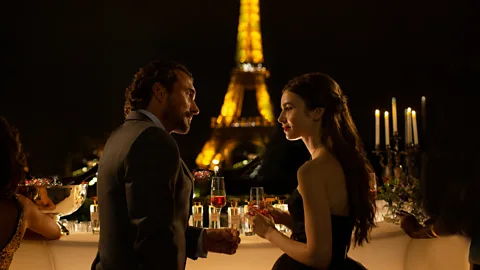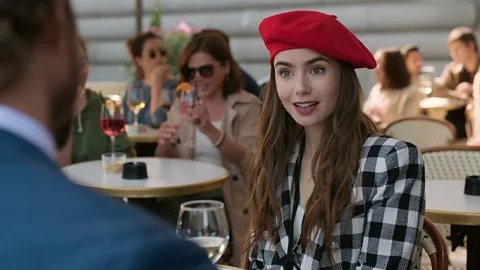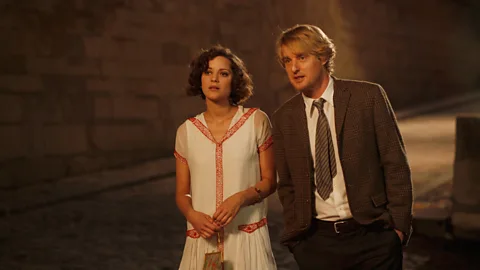Why film and TV get Paris so wrong
 Netflix
NetflixNetflix’s Emily in Paris is the latest work to portray the French capital as a postcard-pretty playground for an American. Where do these fantasies come from, asks Addison Nugent.
“The best of America drifts to Paris. The American in Paris is the best American,” F Scott Fitzgerald once wrote. After 10 years of living as a US immigrant in the French capital, I am still not sure exactly what he meant, but I am sure that he did not envision Emily Cooper, the heroine of Netflix’s new show Emily in Paris.
More like this:
Set a century after Fitzgerald took up residence in the city of lights, Sex and the City creator Darren Star’s new series is the latest work to deploy the ‘American in Paris’ trope which, no matter how many attempts they make, screenwriters just can’t seem to nail. It centres around a young US marketing consultant (played by Audrey Hepburn lookalike, Lily Collins), sent to live in Paris after her firm acquires a French agency. What ensues is a parade of every Hollywood cliché about life in the French capital imaginable, including rude chain-smoking colleagues and romance on every corner. Watching the series’ 10 episodes I was left with the question: how is Hollywood still getting Paris so wrong?
 Netflix
NetflixGrowing up, I obsessively consumed every Hollywood film based in Paris. I sang along with Fred Astaire as he danced down the Champs-Élysées to the tune of Bonjour Paris! in Funny Face (1957); cried with Nicole Kidman in Moulin Rouge (2001); and gazed in wonder at Audrey Tautou’s magical Parisian life in Amélie (2001) – which although French, provides the kind of chocolate-box Hollywood imagining of the capital that presumably made it a worldwide hit. In many ways, when I finally arrived in Paris at the age of 21, beaming ear-to-ear in my first cab ride from the airport, I was a lot like Emily Cooper who, clearly, was fed the same Hollywood myth.
In the show’s opening episodes, we see how she, like so many of us Americans before her, is instantly deflated when confronted by the fact that Paris isn’t how it appears in the movies. Adventure does not wait on every corner. Parisians are generally reserved and it’s very difficult to make friends. Being an American in Paris can be extremely lonely.
However, instead of learning to adapt to the beautifully complicated if somewhat disappointing reality of the French capital, Emily sets about obsessively moulding it to her expectations via her Instagram . The show’s name actually refers to Emily’s Instagram handle, which plays a woefully central role in the series. Instead of giving her 21.7k followers (a statistic that flashes across the screen multiple times) a glimpse of the real Paris, she filters her experience to match her American fans’ assumptions.
This could be a chance for the show to satirise the prettified American view of Paris, but really it just plays into it; like his heroine, Starr gives us a city that is a total fantasy world. Emily becomes an influencer, attends lavish champagne-soaked parties, and meets hunky Parisian men at every turn. “For the most part, American directors paint their depictions of Paris and its culture through either nostalgic or rose-coloured glasses [...]” says Dr Alice Craven, Professor in Film Studies at The American University of Paris. “Audiences, particularly American ones, want to relish the beauty of the city of lights and therefore welcome the misty tints given to the city by these directors.” Again and again, on-screen depictions of Paris, from 1995 Meg Ryan vehicle French Kiss to the climax of Sex and the City, which saw Carrie Bradshaw find her fairytale ending there with Mr Big, have used it as a twinkling backdrop for romantic fantasies.
But where did our rose-tinted vision of the French capital come from?
How the lie developed
It arguably stems from the interwar period when young writers, artists and philosophers of the so-called ‘Lost Generation’ – a term coined by novelist Gertrude Stein – flocked to Paris. In the 1920s bohemian titans like Stein, Ernest Hemingway, Salvador Dalí, F Scott and Zelda Fitzgerald, Man Ray, TS Eliot and Jean Rhys formed a creative coterie – partying together at jazz clubs, exchanging ideas, and generally living the expat dream we now associate with Paris.
Many of the misconceptions about the city swirling around in the US imagination are not really misconceptions at all – it’s just they are 100 years out of date. When Americans hop off the plane at Charles de Gaulle, clutching a copy of Ernest Hemingway’s A Moveable Feast, the author’s seminal memoir about his time writing and gallivanting in the French capital in the 1920s, they may be led to expect to scribble notes at Café de Flore, engage in tense intellectual conversations at the Place de l’Opéra, and sip wine with the city’s literati at Les Deux Magots.
 Alamy
AlamyHowever as soon as they realise Café de Flore is now solely a hangout for American tourists, Place de l’Opéra is a congested hellscape, and a bottle of wine at Les Deux Magots costs a minimum €38 (£34.70), their Parisian dreams are shattered. “Hemingway’s ‘Lost Generation’ may have come and gone, but there’s still a real 21st-Century expat story worthy of being told,” says Vanessa Grall, founder of lifestyle website Messy Nessy Chic and author of Don’t Be a Tourist in Paris. “The gap is wide open for narratives that give Paris the truly breakthrough performance it deserves, but instead, we continue to be fed ones that repeatedly stereotype the city as an Instagram background for soul-searching fashionistas.”
This anachronistic vision of Paris is a central theme in Woody Allen’s 2011 film Midnight in Paris in which protagonist Gil (played by Owen Wilson), a Hollywood scriptwriter bent on becoming a serious novelist, is transported back to the Jazz Age via a magic taxi and experiences the city as it was in the 1920s. For much of the film, Gil is tempted to stay in the past permanently with his new literati friends (including Stein, Fitzgerald, Hemingway, and more) because apparently, he’d entirely forgotten about World War Two or was willing to endure the horrors of the Nazi Occupation just to tag along with Ernest Hemingway during his Moveable Feast days.
In the end, Gil decides to move to Paris but remain in the present. Something that he, as a millionaire scriptwriter, can certainly afford to do, but the average writer cannot these days, easily at least. You see, there was a reason that Hemingway could afford to rent an apartment and an office space while sipping endless bottles of wine and slurping oysters in Saint Germain: after World War One, the Franc was massively devalued, down to 25 to the dollar, so an American could live off a meagre salary and treat Paris like a beautiful playground. This, dear reader, is no longer the case.
Paris is now a wildly expensive city, named (along with Hong Kong and Singapore) the most expensive city in the world in 2019. Rent is astronomical, and Emily in Paris is almost realistic in the type of housing it affords its heroine: instead of putting her in an inexplicably gigantic flat, an estate agent announces that she will be living in the ‘servant’s quarters’: better known as chambres des bonnes, matchbox-sized flats found on the top floor of apartment buildings where rich families’ household staff used to reside. I have lived in more of these over-priced cupboards than I care to mention – the walls are paper-thin, you have to go up a separate ‘servants’ staircase to get to them, and worst of all, everyone on the floor shares a communal toilet.
Except, the cute flat with a separate bedroom and living room where Emily lives is not, I repeat not, an authentic chambre de bonne. In fact, when the camera pans out to Emily beaming in her window you can actually see the real chambres des bonnes located one floor up.
 Alamy
AlamyThe classic Gene Kelly/Leslie Caron musical An American in Paris (1951) has the right idea. In the film’s delightful first scene we see the camera pan up a classic Left Bank building stopping at Kelly’s postage-stamp-sized room. We watch his wannabe artist hero Jerry sleepily go about the process of converting his chambre de bonne from bedroom to living room – a familiar morning ritual for everyone who has ever lived on the dernier étage.
Patricia Field, the famed Sex and the City costume designer who once again teamed up with Starr for Emily in Paris, has said that she was inspired by An American in Paris when deg the costuming. However film fans will find Emily’s outfits bear little relation to An American in Paris’ lavish costuming; instead her look is very much a rich American millennial tourist in Paris. I cross the Pont Alexandre III (where Emily and her colleagues film a perfume commercial seen in the show’s trailer) every day on my way to work and if I ed Emily in her black-and-white checkered suit and aggressive red beret, I would automatically assume her quilted Chanel bag was filled with daddy’s credit cards. In one scene, Emily’s even wearing a buttoned shirt with the Eiffel Tower on it that sells for a cool €333 (£304): the rich girls’ version of the ‘Paris Je t’aime’ shirts peddled on every street corner.
From Sex and the City to Le Divorce, the 2003 Merchant Ivory comedy-drama starring Kate Hudson and Naomi Watts, there is a penchant for costume designers to dress their characters ‘on theme’. American on-screen heroines wear outlandish gowns, head-to-toe Chanel, and prominent berets as they traipse through iconic left-bank locales. Paris is, of course, a fashionable place but the choice to consistently make clothing a central focus in American portrayals of the city points to a deeply shallow understanding of it, as two-dimensional as Emily’s precious Instagram feed; unreal as the MGM sound stages in Funny Face and An American in Paris.
In these films and indeed in Emily in Paris, Paris serves as nothing more than a beautiful backdrop. Sure, the show does get a few small things right: there is dog excrement all over the streets, a fact Emily finds out when she ruins a pair of designer boots; the water does cut off constantly in old buildings; and the French do often respond with a nonplussed ‘Pas possible’ when asked to do something they would rather not. However, just like her 2000s forebear Carrie Bradshaw, Emily does not allow Paris or a different culture to shape her; she tries to shape it into an American idealisation. This notion that somehow Paris is for Americans seems to be Hollywood’s overriding message through the years – whereas if the American in Paris is really the best American, to return to Fitzgerald, it is because they give themselves up to the city in all its beautiful, flawed glory.
Emily in Paris is available on Netflix now
Love film and TV? BBC Culture Film and TV Club on Facebook, a community for cinephiles all over the world.
If you would like to comment on this story or anything else you have seen on BBC Culture, head over to our Facebook page or message us on Twitter.
And if you liked this story, sign up for the weekly bbc.com features newsletter, called The Essential List. A handpicked selection of stories from BBC Future, Culture, Worklife and Travel, delivered to your inbox every Friday.
